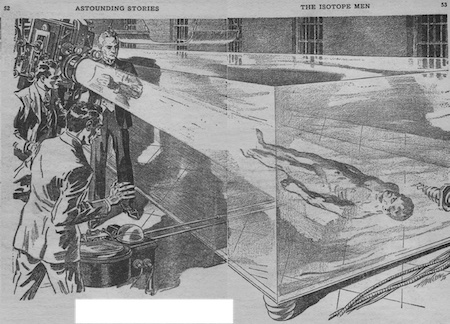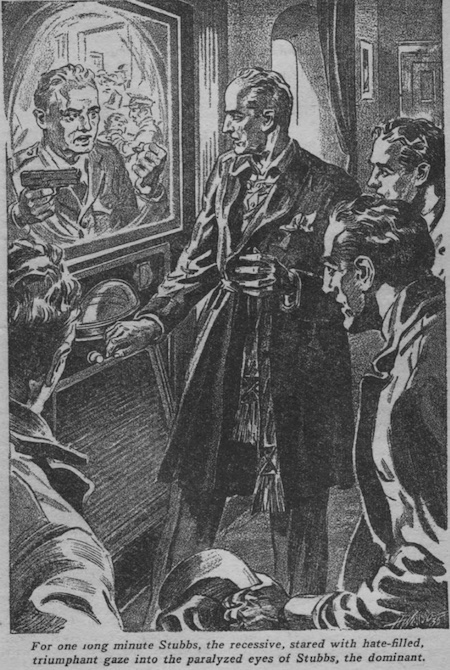Science Fiction
Dictionary
A B C D E F G H I J K L M N O P Q R S T U V W X Y Z
Latest By
Category:
Armor
Artificial
Intelligence
Biology
Clothing
Communication
Computers
Culture
Data Storage
Displays
Engineering
Entertainment
Food
Input Devices
Lifestyle
Living Space
Manufacturing
Material
Media
Medical
Miscellaneous
Robotics
Security
Space Tech
Spacecraft
Surveillance
Transportation
Travel
Vehicle
Virtual
Person
Warfare
Weapon
Work
"I long ago realized that I could reach far more people by writing something, than by walking down the street with a banner."
- John Brunner
| Nutrient Gelatin Tank | ||
| Essential hardware for creating a new, improved humanity - isotope men! |
Jim Horty, convicted and sentenced to death, faced not execution - but a bizarre scientific experiment. The very substance of his entire body was to be dissolved and then only the best of him reconstituted, the recessive decent man would be brought to the fore.
| KEN CRAIG was already at the
huge quartzite tank. Now that the
crucial experiment was already under
way, he became once more the scientist... The great tank was forty feet long,
ten feet wide, and five deep. It was filled almost to the top with a clear,
lusterless jelly. Huge electrodes sank
deep into the thin, quivering stuff at
either end, and were connected by cables
with an instrument board on the wall.
Ken pressed a button. A section of the glass top slid smoothly underneath, leaving the tank exposed just wide enough to admit a human body. Above it, suspended from a miniature crane, was a cradle of extremely thin, longitudinally stretched wires. At a gesture from Ken, the guards lifted the immobile body of the condemned man, deposited it carefully into the cradle. Then he knifed a switch. There was a whir, and the cradle, with its strange burden, dipped slowly from unwinding chains into the transparent substance within the tank. Down, down, ever down, while the men in the room stared with fixed, unwilling fascination. The jelly closed with a quiver over the descending form. Within its clear depths the cradled body showed like a prehistoric monster caught in a huge globule of ancient amber...
 (Nutrient Gelatin Tank from 'The Isotope Men' by Nat Schachner) Stubbs moved quickly to the instrument panel. For an instant his long, bony fingers clung with fierce grip to the bakelite handle of the master switch. His eyes burned through the transparency of the tank, fixed with a fanatical light on the quiescent body within. The future of the world rested on the tug of his hand. If the experiment proved a success, his name would go rocketing down the centuries. Darwin, Newton, Einstein, Galileo would be pale, glimmering phantoms compared to him. A TREMENDOUS current surged through the electrodes. The jelly, at their base, stirred uneasily, blurred slightly with tiny bubbles. Jim Horty was no longer a solid, compact body. He had lost shape and substance. He was stretching out along the plane of vibration in a tenuous, ghostlike flow; he was blurred and misty and unrecognizable; he was a parallelepiped of former length and thickness, but already he was three feet wide and expanding visibly. There was no evidence of the man they had called James Horty any more. He had been swallowed up, ingested seemingly into the horrible plasma that filled the quartzite interior, that was quivering now and bubbling in a veritable witches' broth. Faintly, halfway down the tank, was an amorphous cloud. "It is really quite simple," the scientist explained patiently. "The human body, protoplasm, bone structure and all, is composed chiefly of six elements. Carbon, hydrogen, oxygen, nitrogen, sulphur, and calcium, with a scattering of others. Every one of these has been dissociated into its isotopes. They exist, as far as we know, in indisseverable mixture. But suppose that isn't so. Suppose that some internal mechanism exists in the human body, in each cell, which under certain rare conditions, clicks, and dissociates the isotopes. We already know much about the genes of inheritance within the cell nucleus. We know that there are present, side by side, genes of opposing inherited characters. The stronger, or dominant gene will mask the recessive characters, as if they did not exist. Yet, in the next generation, perhaps, the recessive gene, by proper association, may in turn mask the dominant characteristic." "Why then, I thought," Stubbs went on, "might not the isotopes of the ele- ments in the human body act the same way? Those present in the largest quantity would be dominant, the others recessive. Less than one per cent are the isotopes; the other ninety-nine per cent what we had heretofore considered the entire element. Suppose, as in the case of recessive genes, something happens, and the minority isotopes suddenly mask the dominant norm. What would you have?" The doctor's eyes bulged. "Why, 1 — I'd say you'd have a different personality. The other part of what we've called dual personalities." "Exactly," Stubbs declared triumphantly. "How put it into practice?" Stubbs finished for him. "Easiest thing in the world. The technique for separating isotopes is pretty well established by now. I've improved on it immensely. I've done more than merely shift isotopes within the body. I'm able to separate them entirely, make two separate human bodies, two separate entities, where one existed before, each composed of a unit set of isotopes. I've done what nature has merely fumbled at doing. I've taken the two personalities and clothed them in visible form for the first time in the history of the universe !" "In that tank," pursued the scientist, "is a nutrient gelatin, properly treated to carry an electric current. The injection I gave Horty contained, beside a powerful narcotic, a saline solution to promote conductivity within his body. I am passing a current of extremely high amperage and low voltage through the gelatin. The body dissociates into ions, and, following the laws of electrolytic separation, these ions migrate through the gelatin very slowly from the positive to the negative electrode. "In other words, the heavy, dominant personality will reach the negative electrode first ; the lighter, recessive personality will lag behind." |
| Technovelgy from The Isotope Men,
by Nat Schachner. Published by Astounding Science Fiction in 1936 Additional resources -
|
Was the great scientist able to reintegrate Jim Horty, convicted murderer? Was Horty now the best version of himself?
Jim Horty yawned, opened his eyes,
looked bewilderedly about him... Ken sprang forward, turned them off.
"You're all right now, Horty," he
soothed. "Take it easy. Here are your
clothes."
"You know," he said slowly, and Ken
noted with thumping heart that, though
it was the voice of Horty, yet the diction, the modulations, had changed, become softer, more precise, "I had a
dream, and it was a terrible one. I
must have fallen asleep."
He looked again at his prison clothes,
at Dr. Bascom. Then he smiled wryly.
Somehow his brutish features were suffused with new light. "I'm to be executed, am I not? Well, I'm ready for
it. The sentence was fair and just. I
was a murderer. Funny though," and
again that puzzled look crept into his
eyes, "I must have been crazy, doing
the things I did. Robbery! Murder!
Why, I— I wouldn't hurt a fly!
I won't tell you how it ends, but consider this: what would it be like to confront your worst self?
The man's eyelids fluttered suddenly
under the beating light ; his limbs
twitched ; the warm color of life infused
his limbs.

('The Isotope Men' by Nat Schachner)
Compare to the cosmic express from the 1930 short story of that name by Jack Williamson, the emergency treatment tank from Agent of Vega (1949) by James Schmitz and the way station materializer from Way Station (1963) by Clifford Simak.
Comment/Join this discussion ( 0 ) | RSS/XML | Blog This |
Additional
resources:
More Ideas
and Technology from The Isotope Men
More Ideas
and Technology by Nat Schachner
Tech news articles related to The Isotope Men
Tech news articles related to works by Nat Schachner
| BrainBridge Concept Transplant Of Human Head Proposed |
| Natural Gait With Prosthetic Connected To Nervous System |
| Brain Implant Is Able To Capture Your Inner Dialogue |
| 'Pregnancy Humanoids' From China Replace Moms |
Want to Contribute an
Item?
It's easy:
Get the name of the item, a
quote, the book's name and the author's name, and Add
it here.
| <Previous | Next> |
|
|
|
Technovelgy (that's tech-novel-gee!) is devoted to the creative science inventions and ideas of sf authors. Look for the Invention Category that interests you, the Glossary, the Science Fiction Invention Timeline, or see what's New.
|
Science Fiction
Timeline
1600-1899
1900-1939
1940's 1950's
1960's 1970's
1980's 1990's
2000's 2010's
'Power could be compressed thus into an inch-square cube of what looked like blue-white ice'
'It's so light that you can set it up in five minutes by yourself...'
'Heavy penalties... were to be applied to any one found driving manually-controlled machines.'
'Buy a Little Dingbat... electropen, wrist watch, pocketphone, pocket radio, billfold ... all in one.'
'... an elastic, tinted material that had all the feel and appearance of human flesh and epidermis.'
'It is remarkable that the long leverages of their machines are in most cases actuated by a sort of sham musculature...'
